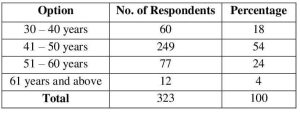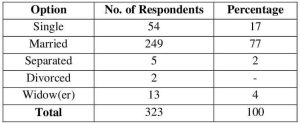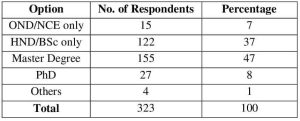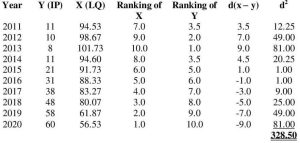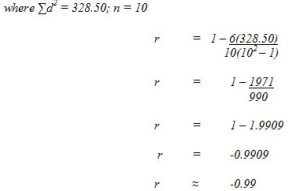|
International Journal of General Studies (IJGS), Vol. 2, No. 2, July-September 2022, pp. 88-102 https://klamidas.com/ijgs-v2n2-2022-05/ |
||
|
Leadership Quality and Performance of Nigerian Polytechnics By Florence Eguonor Omonzejele & Cyril Obiora Agu* Abstract This study was set out to review the relationship between leadership quality and performance of Nigerian Polytechnics, using Auchi Polytechnic, Auchi, as a case study. The spearman rank correlation statistics was used to test the relationship between the variables. The value of the correlation coefficient (r = -0.99) revealed a strong inverse relationship between the variables, implying that an increase in leadership quality leads to decrease in the rank value of the Polytechnic and increase in performance. The study concludes that a proactive and visionary leadership is needed in Nigerian Polytechnics to help meet their mandates. The study recommended, among others, an individual with the requisite qualifications (academic and professional); and management skills to occupy the ‘Rector’ position in all Polytechnics across Nigeria, at any point in time. Keywords: leadership quality, institutional performance, polytechnic. Introduction It is no longer news that the Nigerian economy has continued to dwindle. This is not surprising because education, as a major pillar of the economy, is on the decline in terms of quality. George (2018) lamented that the quality of learning is pitiable and the standard of education offered in Nigeria disgraceful. This stance was supported by Olamide and Tobiloba (2020) who said “the quality of tertiary education in Nigeria is disgracefully low and Nigerian graduates are no match for their counterparts in other parts of the world”. Higher education plays a consequential role in sustainable development as it equips the “next generation of sustainability leaders with knowledge and essential skills” needed for proactive leadership (France, Saito, Vanghter, Whereat, Kaine & Takemoto, 2018). Unfortunately, Nigerian higher educational institutions especially Polytechnics face a lot of challenges which have hindered development in the country. One of these challenges as noted by Asiyai (2017) is poor leadership; she cited “injudicious utilization of funds by implementation agencies” such as Government and Management as examples of how poor leadership has negatively affected development in Nigeria. Polytechnics have been treated as second fiddle in the Nigerian higher educational system. This is due to their poor performance (Chiemeke, Longe, Long & Shaib, 2019). This is disturbing, and especially so, since Polytechnics were set up to fill the technological needs of the country through self-dependence and self-sustainability. There are many local and international studies on the effect of quality leadership on higher institutional performance. However, no known study has addressed this effect with respect to Polytechnics, using Auchi Polytechnic, Auchi as a case study; and covering the years 2011 to 2022. Thus, the purpose of this work was to show the relationship between quality leadership and Polytechnic performance in Nigerian using Auchi Polytechnic, Auchi as a case study. The study covers a period of ten (10) years from 2011 – 2022. The hypothesis of the study is hereby stated as: Ho: There is no relationship between leadership quality and institutional performance of Auchi, Polytechnic, Auchi. Literature Review Institutional Performance Performance is the management of progress which ranges from measuring to reporting as to improve outcome at the individual and corporate levels (Marr. 2020). It is therefore a measure of value created by a group, individually or collectively to achieve stated objectives and gain competitive advantage. Institutional performance is the actual results of an institution’s performance in achieving its goals and objectives (Bashaer, Anigh & Sherine, 2016; and Kangal, 2021, 2021). It is an ideology viewing an organization or an institution as a “variety association of productive assets” (Carton, 2004), including all forms of resources whether human, capital or physical, with the aim of achieving a shared purpose. The essence is value creation. Gavrea, (2011) listed leadership as one of the determinants of organizational/institutional performance. This is note worthy, as Asiyai (2017) later emphasized poor leadership as one of the major actors facing Polytechnics in Nigeria and hindering national development. Leadership Quality Hackman and Wageman (1995) viewed quality as the responsibility of top management. This implies that the achievement of management is based on the quality of leadership of the organization. McNair et al (2011) in Bashaer et al (2016) viewed leadership as the “art of motivating team or group of people so that they act appropriately to achieve a given common goal”. Leadership includes strategic orientation which according to Deshpande et al (2013) in Ahmed, Khuwaja, Brohi and Othman (2018), “represents the direction of an organization to create the proper organizational behavior which can achieve its shared goals”. Leadership, especially transformational leadership, has been viewed as a key element or success factor in organizational performance (Papanthymou & Darra, 2017; Edo, Chukwusa, & Uzoma, 2018). In an earlier work, Modanchian, Hussein, Noordin and Taherdoost (2016) had argued that transformational leadership could be categorized by “optimistic, trusted and positive leaders who emotionally encourage teamwork and set support innovations”. They felt that “transformational leaders create a strategic vision, communicate that vision through enclosing and use of symbol, model the vision by walking and acting consistently at building commitment toward the vision”. Therefore, one could agree that the performance of any organization depends in large, on the level of skills and competencies its leaders possess when it comes to implementing strategies (Bashaer et al, 2016). Leadership competencies represent means of creating followers through skills and knowledge. Such competencies include monitoring and coaching, leading and motivating, problem solving and decision-making, proper communication, influencing and negotiating (Lee et al, 2015 in Bashaer et al, 2016; Tomal and Jones, 2015). The competencies of a leader also involve his or her abilities to persuade other people on behalf of the organization, to complete the task required to accomplish the objectives of the organization and to communicate its vision to others. A good leader must be inspirational, motivational, display honesty, have integrity, visionary, possess good communication skills and have a good sense of humor. (Meraku, 2017) Meraku (2017) emphasized top-down communication as a means a leader uses to communicate the policies, procedures and new offers that a company provides. He also described bottom-up communication as a means to communicate subscriber complaints, to present ideas and to express the problems faced by employees at work. Hence, the role of communication in leadership cannot be underscored. Effectiveness is another critical function of a leader which determines, to a great extent, the performance of an organization. An organization is said to be effective if it meets the needs of all its stakeholders and strikes a balance in doing so (Meraku, 2017). Effectiveness of an organization depends on its efficiency and process reliability, human resources and relations, innovation and adaptation to environment (Yuki, 2016 in Karamat, 2013). In all of these, leadership plays a key role. According to Karamat (2013), the effective leader is one with an effective leadership style. In modern times, transformational, visionary leader is the focus. Effective leadership is essential not only in organizations that deliver products, but in institutions of higher learning which provides service delivery such as Polytechnics. Below are few empirical works on the effect of leadership on organizational /Institutional Performance. Madanchian, Hussein, Noordin & Taherdoost (2016) explained the effect of leadership styles, with particular reference to transformational leadership, on increase in organizational performance using a qualitative approach. The study concluded that there is a positive relationship between the transformational leadership style and the performance of the organization. They recommended the analysis of the nature of the relationship between transformational leadership and organizational performance for future studies. Papanthymou and Darra (2017) presented a summary of 52 studies from 2006 to 2016 of quality management in higher educational institutions in developing countries such as Arabic Countries. The aim of the study was to submit evidence regarding the level of quality management in these institutions with a view to enhancing research in the field of TQM. The findings revealed that from 2013 onward, there has been an increased interest in items of TQM such as the age and type of the university, transformational leadership, integration, respect of a person character, constructive conflict, orientation of employees and faculty as well as resource allocation. The study identified both obstacles and benefits of quality management in these institutions. The study recommended further study on comparison between Western developed countries and other developing countries of the world. Edo, Chukwusa and Uzoma (2018) theoretically reviewed quality management strategies and students’ academic performance in Nigerian Universities. The purpose of the study was to examine the population of quality management (quality of academic staff, quality of physical facilities, quality of students assessment, quality of teaching methods and quality of curriculum content) on the performance of these institutions. The study concluded that quality management reflected on monitoring, appraisal, supervision and evaluation of the various instructional programmes for the enhancement of students’ academic performance in the universities. The study recommended constant monitoring of programmes, persistent supervision of physical facilities and personnel for the realization of the pre-determined objectives as well as accreditation of the available facilities and programmes for the determination of the strength and weaknesses of these institutions. Mahamda (2019), in a research work titled: implementing total quality management in Palestine higher education institutions and its relationship to the institutional performance, carried out a survey using questionnaires from faculty deans of the institutions surveyed. The questionnaires were analyzed by SPSS to assess the level of TQM implementation and its relationship to the performance of these universities. The study found that there was strong positive linear relationship between information and analysis implementation and performance; a moderate positive relationship between performance and each of strategic planning and leadership, and finally a weak positive relationship between performance and process management. Methods This is a survey study of the descriptive research design. The study covered a period of ten years (2011 – 2020), showing whether there was a significant relationship between leadership quality and performance of Auchi Polytechnic, Auchi for the years in question. Performance of the Polytechnic was gotten online from ranking of Auchi Polytechnic for the relevant years by Webometrics and other agencies responsible for the ranking of higher institutions of learning. The ranking of the Polytechnic shows its relative position (in terms of overall performance) to other higher institutions of learning in Nigeria (the lower its position, the better its performance in relation to others). Questionnaire was administered to 323 staff of the Polytechnic, to assess the leadership quality of the institution for the relevant years. The questionnaire was divided into two sections: Section A covered the bio-data of respondents; while Section B covered the questions designed using 5 point Likert scale, for hypothesis testing. For leadership quality, the questionnaire was analyzed using weighted average to get a single figure for a particular year, in all the relevant years of study. Questionnaire Section A (Biodata of Respondents) Kindly tick the appropriate option
30 – 40 years ( ) 41 – 50 years ( ) 51 – 60 years ( ) 61 years & above ( )
Single ( ) Married ( ) Separated ( ) Divorced ( ) Widow/Widower ( )
OND/NCE ( ) HND/BSc ( ) Master Degree ( ) PhD ( ) Professional ( ) Others ( )
10 – 20 years ( ) 21 – 30 years ( ) 31 years & above ( ) Analysis of background characteristics of respondents Simple percentages were used to analyze the background characteristics of the respondents such as age, sex, level of experience and qualification. Table 1: Sex Distribution of Respondents
Table 1 above shows that 206 (64%) of the respondents are males while 117 (36%) are females. Though there were more male respondents than female, the sex distribution is fair enough. Table 2: Age Distribution of Respondents
Table 2 above shows that the majority of the respondents (54%) are between 41 – 50 years of age. This age range is the most active of service years because it usually combines maturity and general experience in life and service in viewing and handling issues. Thus any response on the impact of leadership on the performance of Auchi Polytechnic, Auchi, from the respondents of this age bracket can be generally relied upon. Table 3: Marital Status of Respondents
Table 3 above shows that the majority of the respondents 249 (77%) are married with their spouses living with them. One could reasonably conclude that the respondents are psychologically stable enough to give reliable answers to the questions raised. Table 4: Qualification of Respondents
Table 4 above shows that 92% of respondents have at least a first degree or its equivalent. In addition, 208 (64%) respondents have professional qualifications in their respective fields of study. Therefore, the respondents are both academically and professional qualified to contribute to issues of institutional performance especially as they relate to Auchi Polytechnic, Auchi where they work. Table 5: Length of Service
Table 5 above shows that most of the respondents have worked long enough in Auchi Polytechnic (about 70% of respondents have spent at least 21 years in service) to contribute meaningfully to the issue of leadership raised in this study. Section B Please tick the appropriate option. NOTE: VG = Very Good, GD = Good, FR = Fair, PR = Poor, VP = Very Poor. SA = Strongly Agree, A = Agree, U = Undecided, D = Disagree, SD = Strongly Disagree.
For the purpose of this study, the model is specified as: IP = F(LQ) ………. (i) where: IP = Institutional Performance LQ = Leadership Quality Based on the study objective, the spearman rank correlation coefficient (r) was used to estimate the statistical dependence between the ranking of the Polytechnic’s performance for the years under study and the rating of its leadership quality (from respondents) as seen in questionnaire above, for the same years. The spearman rank correlation statistics was used because the data for the study are ordinal and are based on ranking and ratings. The ‘r’ is expected to have a negative value showing an inverse relationship. This means that an increase in leadership quality (LQ) will lead to a decrease in the numerical value (ranking) of the Institutional Performance, suggesting an increased level of performance. The spearman rank correlation coefficient is given by:
The hypothesis of the study is again stated as: Ho: There is no relationship between LQ and IP of Auchi Polytechnic, Auchi. The value of the spearman rank correlation coefficient (r ≈ -0.99) shows a strong statistical relationship between leadership quality and institutional performance of Auchi Polytechnic, Auchi, in the period under study. An increase in the value of leadership quality leads to a decrease in the ranking position of the Polytechnic. The meaning of a low ranking position is actually an improvement in performance in relation to other institutions. The implication of this is that a positive change in leadership quality will lead to a positive change in performance of the Polytechnic. This is consistent with previous studies done by Bashaer et al 2016; Papanthymou and Daira 2017, who argued that leadership is a critical instrument of achieving effective and efficient organizational performance. Summary The leadership skills and competencies of any organization is a major determinant of its performance. In the Polytechnic setting, leadership theoretically lies with the management team. However, the case of Auchi Polytechnic, Auchi shows that leadership is majorly a function of the Chief Executive – The Rector. A Rector who is proactive, pragmatic, visionary and believes in team work often drives the institution to a greater height as was felt in the period 2008-2012. During this period, the Rector (Dr. Mrs. Idogho, Philipa) spelt out her vision to make Auchi Polytechnic the best in Africa. To achieve this, she encouraged employees to engage in further studies. Different kinds of academic training, workshops, conferences were made available for man power development. Both teaching and non-teaching staff were given the opportunity to engage in all forms of training and development locally and internationally. Approval for part time studies was never denied any staff. In the period 2008-2012 different Professional bodies were invited to the Polytechnic to train staff and help them qualify professionally. Within this period, the increase in the level and quality of academic activities of Auchi Polytechnic could be felt within and outside the Polytechnic. Staff were encouraged to carryout innovative research and publish such in recognized and reputable journals. The level of ICT also increased as Auchi Polytechnic, thus ranking it high in webometrics. In fact, the per capital academic performance of the Polytechnic was the highest during this period. Sadly, the leaders after her (in the period under review) could not maintain the status quo. Thus, the Polytechnic suffered a setback between 2016 and 2020 as could be seen in its ranking for those years. In view of the above, the importance of proactive and visionary leadership cannot be over emphasized. Nigerian Polytechnics need leaders who can drive, push and elevate them from their current standing to the desired position, thereby making them instruments for change and national development through innovation and modern technology. Conclusion The study concludes as follows:
Recommendations The study recommends as follows:
References Ahmed, A. Khuwaja, F. M., Brohi, N. A. & Othman, I. L. (2018). Organizational factors and organizational performance: A resource-based view, social exchange theory view point. International Journal of Academic Research in Social Science, Vol. 8(3) 579 – 599 Asiyai, R. I. (2017). Challenges of quality in higher education in Nigeria in the 21st century. International Journal of Educational Planning and Administration, Vol. 3(2) 159 –172. Retrieved 16th March, 2021 fromhttps:// www.ripublication.cm/ijepa.htm. Bashaer, A., Singh, S., & Sherine, (2016). Determinant oforganizational performance: A proposed framework. International Journal of Productivity & Performance Management, Vol. 65(6), 844 – 859 Carton, R. B. (2004). Measuring organizational performance: An exploratory study. Unpublished PhD Thesis, University of Georgia, Athens. Chiemeke, S., Longe, O. B., Longe, F., & Shaib, I. O. (2019). Research output from Nigerian tertiary institutions: An empirical appraisal. Retrieved 15th March, 2021 from https://www.researchgae.net>publication Edo, B. L., Chukwusa, O. M. & Uzoma, F. O. (2018). Quality management strategies and students’ academicperformance in the Nigeria Universities. International Journal of Innovative Development & Policy Studies 6(1) 21-26. Retrieved 20th January, 2021 from https://www.seahipaj.org Franco, I., Saito, O., Vaughter, P., Whereat, J., Kanie, N. & Takemoto, K. (2018). Higher education for sustainable development: Auctioning the global goals in policy, curriculum and practice. Retrieved 5th August, 2022 from https:// doi.org/ 10.1007//s11625 -018-0628- 4 Gavrea, C.. O;oes, L., & Segerean, R. (2011). Determinants of organizational performance: The case of Romania, Management and Marketing Challenges for the Knowledge Society, Vol. 6(2) 285 – 300 Hackman, J. & Wageman, R. (1995). Total quality management: Empirical conceptual and practical issues. Administrative Science Quarterly, 40(2), 309-342. Retrieved 10th February, 2021 from https://www. DOI.10.2 :07 /2393640 George, O. A. (2018). The causes and effects of falling standard of education among secondary students in Gwagwalada Area Council. Retrieved 25th February, 2021 from https://www. afribary.com >works> the-cause-of Kangal, S. (2021). Organizational performance: Definitions, factors, and models. Retrieved 1st March, 2021 from https://www. IEduNote.com Karamat, A. H. (2013). Impact of leadership on organizational performance. A case study of D & R Cambric Communication. University of Applied Sciences. Retrieved 20th January, 2021. Retrieved from https://www.dokumen. tips>document Madanchian, A., Hussein, N., Noordin, F. & Taherdoost, H. (2016). Effect of Leadership on Organizational Performance: Economics and Education. Retrieved 5th August, 2022 from https://www.scirp. org> reference Mahamda, M. K. (2019. Implementation of total quality management (TQM) in Palestinian higher education institutions (Birzeit University, An-Najah National University, Al-Quds University) and its relationship to the institution performance. IOSR Journal of Business and Management (IOSR-JBM), Vol. 21(7), 65 – 82 Marr, B. (2020). Key tools and techniques for performance management. Retrieved 20th February, 2021 from https://www. bernard marr.com Meraku, A. (2017). Role of leadership in organization effectiveness. Journal of Economic, Business and Management, Vol. 5(11). 336-340. Retrieved 26th January, 2021 from DOI:1018178/ joebm.2017 .5.11.535 Olamide, L. & Tobiloba, A. (2020). Improving the quality of tertiary education in Nigeria. Retrieved 5th August, 2022 from http://www. businesday.ng Papanthymou, A., & Darra, N. (2017). Quality management in higher education: Review and perspectives. Higher Education Students 7(3); 132. Retrieved 20th January, 2021 from https:// researchgate.net >publication Tomal, D. R. and Jones, K. J. (2015). A comparison of core competencies and men leaders in the manufacturing industry. The Coastal Business Journal, Vol. 14(1), 13-25. *About the Authors: Dr Florence Eguonor Omonzejele (florenceomonzejele@yahoo.com) & Cyril Obiora Agu (agu.cyril4life@gmail.com) are of Auchi Polytechnic, Auchi, Nigeria. |
||


